Wondering how to visit the Panama Canal? This guide shares the best way to see the Panama Canal from all three viewpoints – both independently and with a guide.
One of the unmissable things to do when visiting Panama City is to visit the Panama Canal. It’s on every to-do list and itinerary.
Synonymous with Panama, it’s an engineering feat that has to be seen in person to be believed.
To be honest, I’m not usually that interested in visiting or seeing engineering marvels, but I was completely blown away by the size, power and ingenuity of the Panama Canal.
Looking down on the huge torrents of water flowing through the locks and the massive steel doors that slam shut to control the flow of water, it’s hard not to be impressed.
I was so impressed with the Panama Canal that we visited not one but two of the three viewing areas.
To help you plan your visit so you can also be awed, read on for my tips on the best way to see the Panama Canal. I’m including information on how you can visit each of the viewing areas either independently or with a guide, depending on your preference.
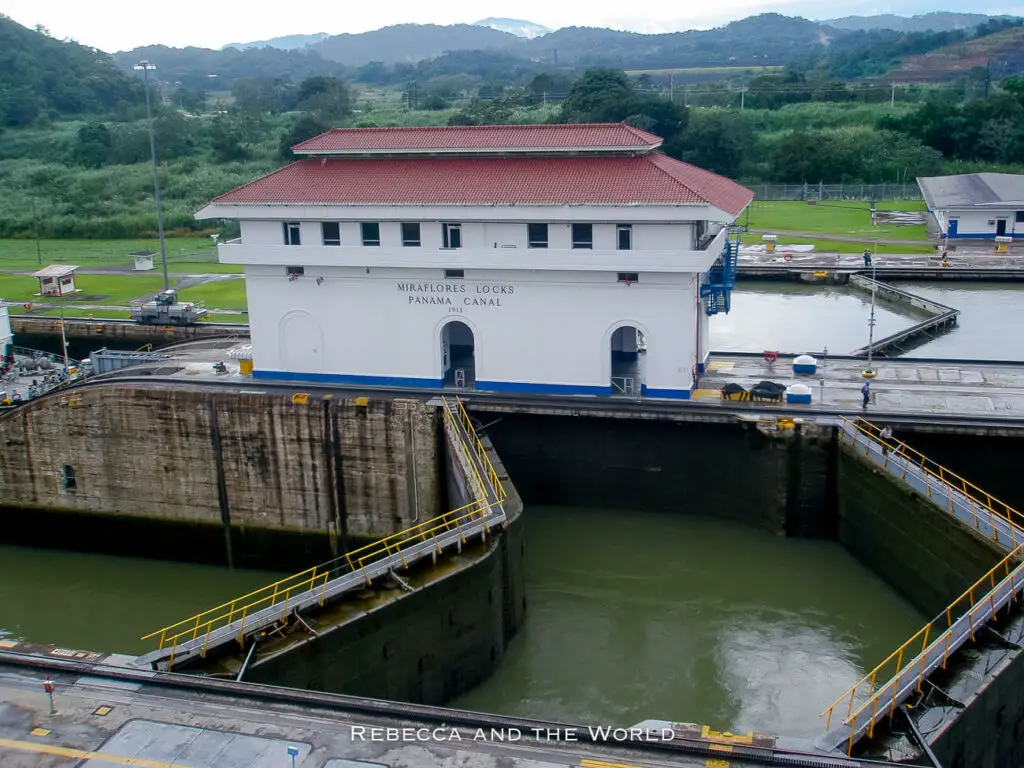
This blog post may contain affiliate links, meaning if you book or buy something through one of these links, I may earn a small commission (at no extra cost to you).
A brief history of the Panama Canal
Today we know the Panama Canal as a handy shortcut between the Atlantic and Pacific oceans. This saves vessels around two weeks if they were to navigate all the way around the tip of South America, and avoids the perilous Cape Horn and Drake Passage.
But the idea of a canal was first floated (pun intended) way back in the early 1500s by Vasco Nuñez de Balboa, the Spanish explorer.
Despite the early idea, it wasn’t until the 1800s that the French made attempts to create a canal – all of which failed.
During those failed attempts, it’s estimated around 22,000 people died, mostly due to diseases like yellow fever. (A further 5,000 died during the later construction period.) The French abandoned the project in 1889.
In 1904, the United States took control and construction was underway in earnest. The canal was officially opened in 1914, but it wasn’t actually handed over to Panama until 31 December 1999.
In 2007, the Panama Canal expansion project began, designed so the canal could handle today’s megaships. The project aimed to double the capacity of the canal by adding a new shipping lane, and increasing the width and depth of the locks so that larger ships could pass through. The first commercial operation through the expanded canal was in 2016.
How does the Panama Canal work?
So how does the Panama Canal work exactly?
In very simple terms, ships enter into a lock and gates close around it, making a watertight chamber. Water flows in to fill the space, causing the ship to rise up to the water level of the next lock.
Once the ship is at the right water level, the gates open and the ship transits to the next lock and the process begins again.
When you visit the Panama Canal, you’ll have a chance to see all of this in action – and right up close.
The canal’s three lock systems control the flow of water, lifting and lowering the water level to allow ships to pass through from the Atlantic Ocean to the Pacific, and vice versa. These locks are required because the Atlantic and Pacific oceans are at different levels.
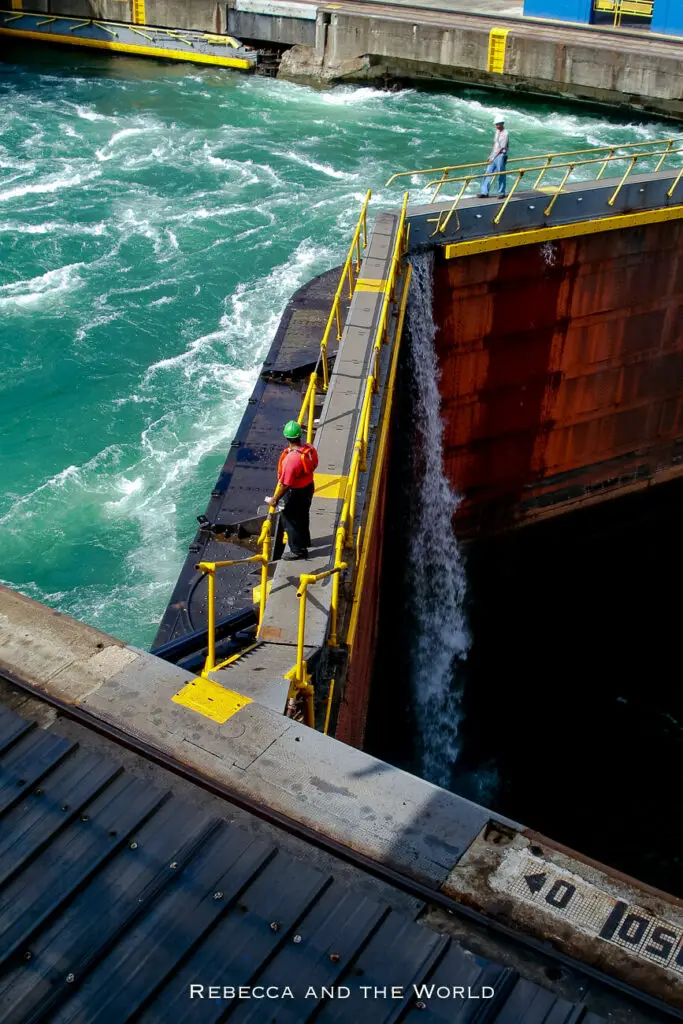
The Miraflores Locks raise and lower ships 16 metres, the Pedro Miguel Locks 9 metres, and the Gatún Locks raise and lower vessels 26 metres.
As the ships pass through the locks, they must relinquish control to a pilot from the Panama Canal Transit Authority. This is one of the few times this ever happens on a ship!
The amount of fresh water that is flushed into the sea as each ship passes through is staggering: 100 million litres. Did I say per ship?
Ships are designed and built to fit through the canal – and with the now-completed expansion, larger ships are being built. It takes 8-10 hours for boats to transit through the 80-kilometre-long Panama Canal, and about 15 minutes to pass through each lock. Around 13,000 tankers, container ships and cruise ships pass through the canal every year.
For the most part the Panama Canal is a two-way street, but there are sections that are too narrow for ships to pass each other, so there’s a tight schedule to manage this. Ships pass from north to south for 12 hours a day and then the direction changes for the next 12 hours.
Every ship that passes through must pay a toll. The largest toll ever paid was almost $4 million by a Japanese shipper who wanted to jump the queue. The lowest toll ever paid was a mere 36 cents in 1928 by adventurer Richard Halliburton who swam the canal.
How to visit the Panama Canal
To see this incredible sight in action, you need to head to one of the three locks along the canal:
- Miraflores Locks – closest to Panama City, this is the busiest of the three locks and how most people tour the Panama Canal. On site is a modern visitor’s centre with videos showing the construction of the Panama Canal. This is the best and easiest way to visit the Panama Canal.
- Gatun Locks – located in Colón, about 80 kilometres from Panama City, these locks receive fewer tourists.
- Pedro Miguel Locks – while these locks can’t be visited, they can be seen from the highway.
If you’ve got a bit of time, you could consider a Panama Canal cruise to see all three locks. It’s not something I’ve had the chance to do yet, but cruising through the Panama Canal is on my bucket list!
Several companies offer partial transit options that go through only one or two locks. This boat cruise is southbound, while other boat tours are northbound. Or go all the way and book a full transit of the Panama Canal.
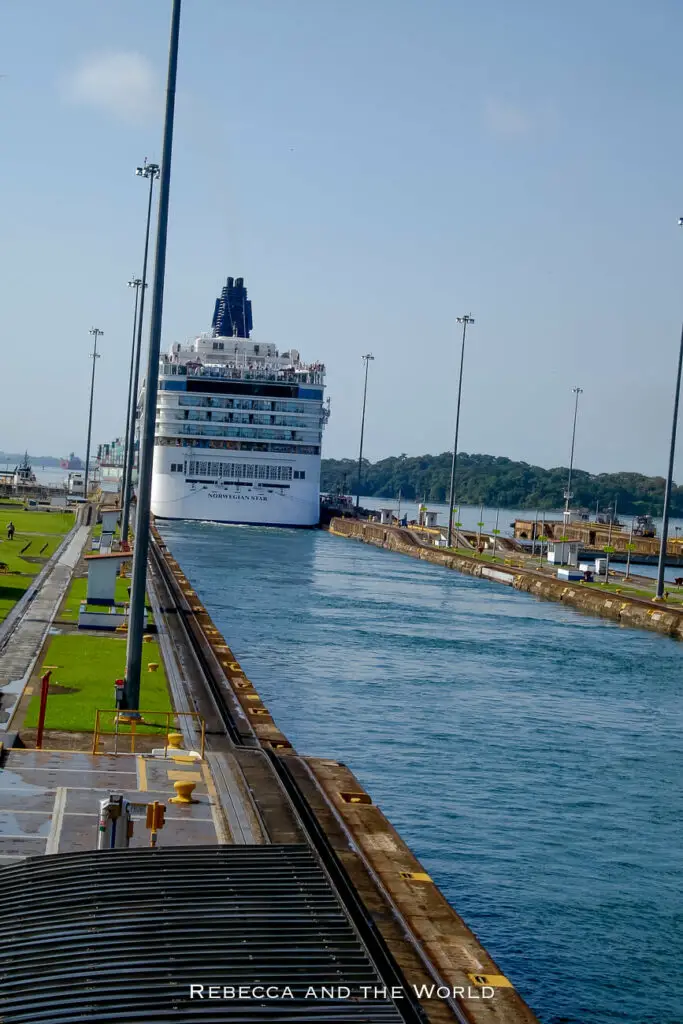
How to visit the Miraflores Lock
The easiest way to see the Panama Canal is to visit the Miraflores Locks.
It’s got a great museum with several exhibitions that share a heap of Panama Canal facts, an IMAX theatre, a restaurant and three observation terraces that overlook the canal.
Of course, with all these facilities and its proximity to Panama City, it is also the busiest of the three locks.
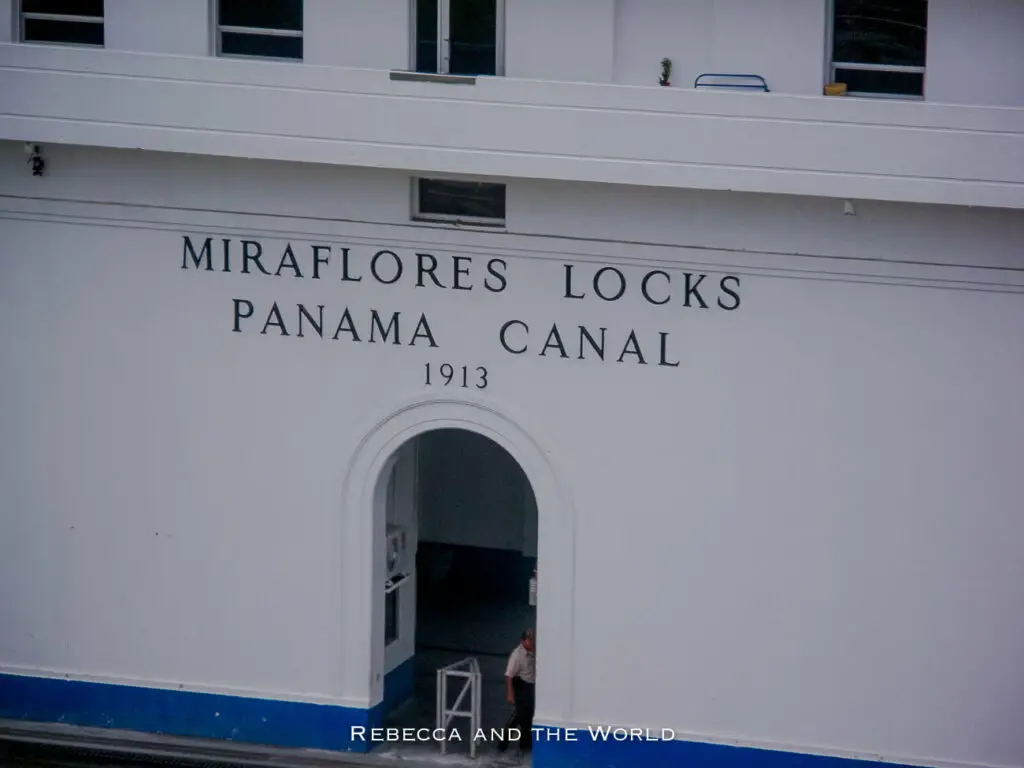
The best time to visit the Panama Canal is between 9am and 11am and from 3pm and 5pm when ships are more frequent. Around 11am the Panama Canal changes direction, which takes some time, so there’ll be no ship sightings at this time. You can view the schedule online or call ahead to confirm.
While the thought of watching a ship pass through a lock may not sound exciting, trust me when I say that I was completely in awe of this incredible sight.
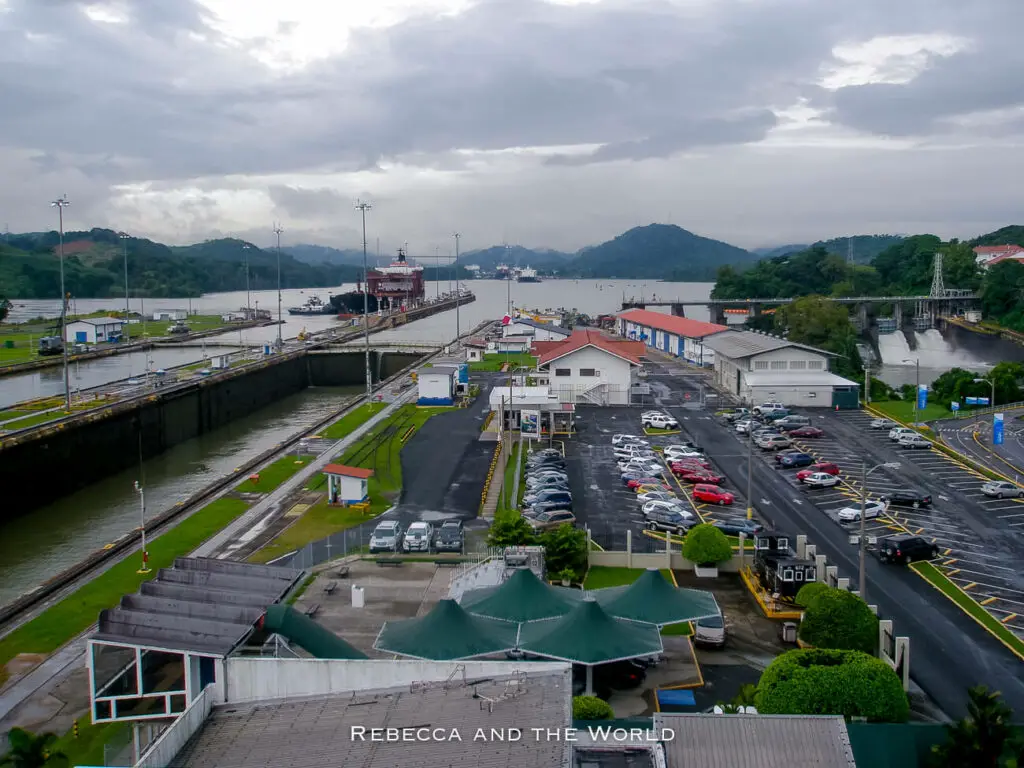
During our visit to the Panama Canal we joined the crowds along the windswept terrace and gazed down upon the gushing water and huge ships passing through. It was impressive, but it certainly wasn’t intimate. So, read on for what I think is the best way to see the Panama Canal!
Miraflores Locks Cost
B/.17.22 for non-resident adults (around US$16.92).
Opening hours
The Miraflores Locks visitor centre is open daily (including holidays) from 8am until 6pm.
How to get to the Miraflores Locks
A drive from downtown Panama City will take around 45 minutes, whether by private car, taxi or Uber.
Alternatively, you can take any Paraíso or Gamboa bus from the Albrook Bus Terminal. Get off at the Miraflores Locks sign. Bus rides in Panama City are very affordable and, since the crazy Diablos Rojos buses (red devils) were abolished, safe and easy to use.
The city’s hop on and hop off bus also has a stop at the Miraflores Locks.
How to visit the Gatún Locks
After visiting the Miraflores visitor centre, we decided to see another side of the canal, and boarded the Panama Canal Railway bound for Colón, located on the Atlantic Ocean.
The glass-domed train is a two-hour round trip, and the journey to Colón is a picturesque journey along the canal.
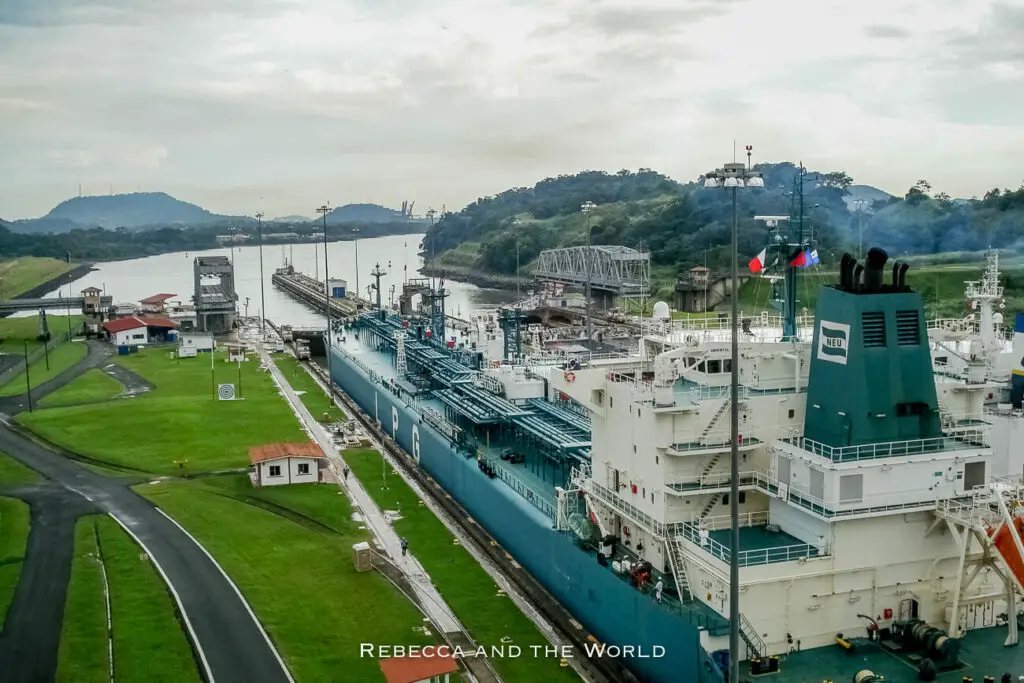
Before I go on, it’s worth mentioning that Lonely Planet once described Colón as “best avoided” and capable of sending “shivers down the spines of hardened travellers and Panamanians alike”.
We had no problems while we were there, and I didn’t feel unsafe, but our driver did surreptitiously show us the gun he kept in his glove box (although he wouldn’t tell us if he’d ever had to use it before).
He also cautioned us against travelling alone, and was very reluctant to drop my female friend and me off at the bus stop by ourselves after we’d finished visiting the Panama Canal. While I had my suspicions about his motives, and guessed that he would have preferred to keep us scared so we’d continue to use (and pay for) his services throughout the day, I’m not going to argue with a big guy with a gun.
Having painted that wonderful picture, I would still strongly urge everyone to visit these locks. The train ride there is spectacular and the viewing area is so much quieter than the Miraflores Locks.
The Gatún Locks – only about 10 minutes by car from the train station – were amazing. We were the only people there, and the viewing platform was so close we could almost reach out to touch the vessels inching past, each barely centimetres from touching the sides of the lock.
The Agua Clara Visitor Centre at the Gatún Locks has a projection room showing a historical video, a coffee shop, restaurant and a children’s area.
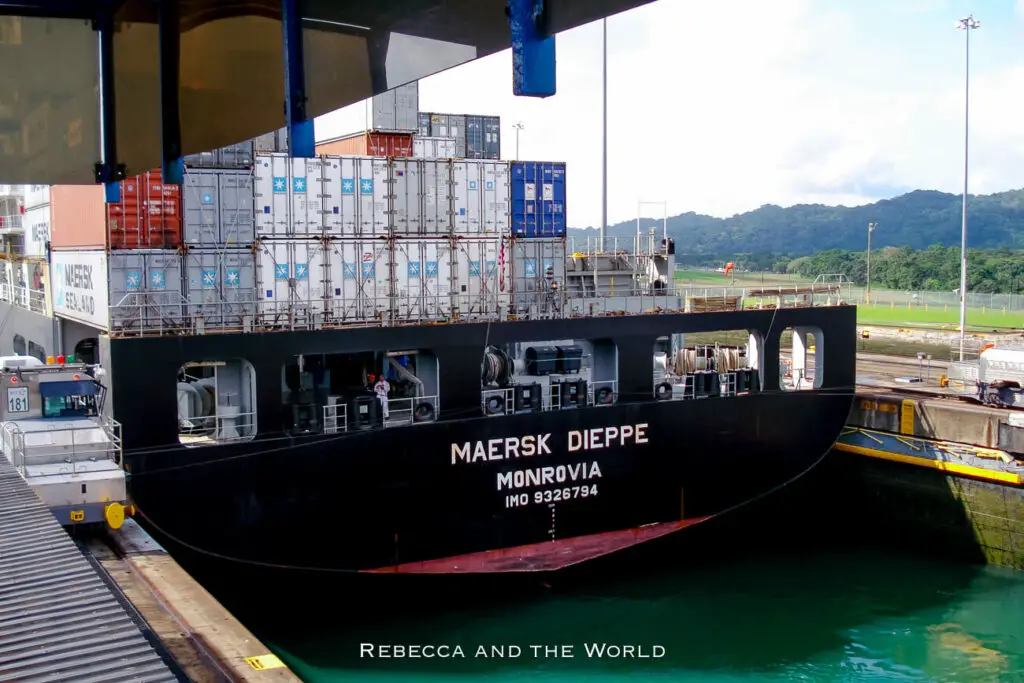
We got the full treatment from the man in charge. He told us the history of the canal, showed us the records of some of the ships that had passed through that day, and explained how the pilot system works (a ship captain has to hand over control to one of the Panama Canal pilots, who guides the vessel through the entire length of the canal – it’s the only place in the world where this happens).
Cost
B/.15 for adults and B/.10 for children 6 to 12 years. Free for children under 6 years of age.
Opening hours
The Agua Clara Visitor’s Centre is open daily, including holidays, from 8am until 4pm.
How to get to the Gatún Locks
The best way to get to the Gatún Locks is via the Panama Canal Railway, which runs between Panama City and Colón. Tickets are around US$40 per adult. You’ll then need to take a taxi from the station to the locks. Negotiate to get the best price!
Note that the train runs Monday to Friday only.
Tour companies can organise day trips, such as this tour to the Gatun Locks from Panama City.
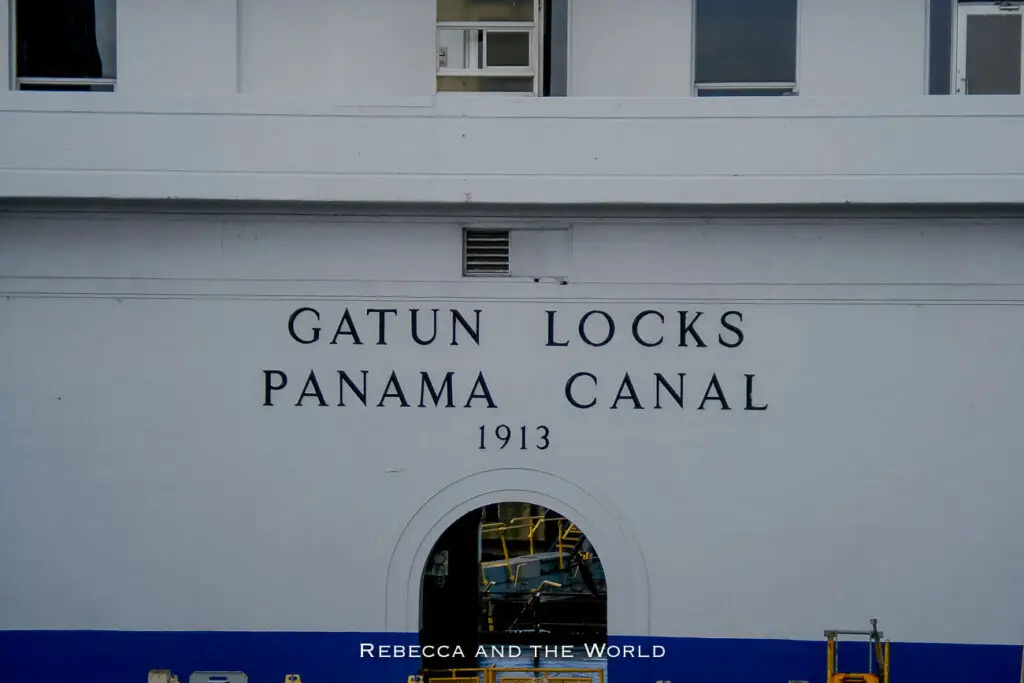
How to visit the Pedro Miguel Locks
The Pedro Miguel Locks does not have a visitor’s centre, but you can get a good view of the activity at the locks from the car park and the highway.
This is the cheapest way to see the Panama Canal, although you’re not going to have the same experience as you would at the other Panama Canal locks. You really can’t see a whole lot.
Cost
Free
Opening hours
24 hours – there’s no visitor centre (see above)
How to get there
The Pedro Miguel Locks are a 10-minute drive from Miraflores.
The best time to visit Panama City
Located in the tropics, Panama City has a balmy year-round temperature of 24°C to 29°C (75°F to 85°F).
The best time to visit Panama City is from mid-December to mid-April during the summer dry season. Of course, this is also the high season with more tourists and higher prices.
Humidity is high, particularly during the wet season. During the wet season, from May to early December, you can expect plenty of short-lived downpours throughout the day – but you’ll still be able to get out and about to see the city.
How to get around Panama City
It’s fairly easy to get around Panama City, with plenty of transport options:
- Taxis are plentiful and cheap. Negotiate with the driver before you get in, as taxis don’t have meters.
- Uber is thriving in Panama City. It’s just as simple to use as in any other major city in the world.
- Panama City has an extensive bus and metro system that is cheap and easy to use.
- The city also has a hop on hop off bus that makes stops at the major tourism attractions.
Where to stay in Panama City
By far the best area to stay in Panama City is Casco Viejo (also sometimes referred to as Casco Antiguo). It’s full of beautiful old buildings that are a stark contrast to the skyscrapers of Panama City.
Recommended accommodation options in and out of Casco Viejo include:
- W Panama brings the hotel’s usual hip luxury and great dining and bar options (Calle 50 and Aquilino de la Guardia). Check prices and availability.
- The American Trade Hotel has the bonus of a swimming pool – perfect after wandering the streets all day (Plaza Herrera). It’s in a beautiful building. Check prices and availability.
- Tantalo Hotel is a hip boutique hotel with a happening rooftop (Calle 8 Este con Avenida B). Check prices and book your room online.
Safety in Panama City
A lot of people ask me: Is Panama City safe to visit? I can only speak to my experience, and we felt very safe and had no issues.
Considered the most modern city in Central America, you can stay safe in Panama City by following a few precautions:
- Only use the yellow licensed taxis.
- Don’t wander around at night, and don’t stroll into unknown neighbourhoods alone even during the daytime.
- Be careful with your cash and only carry with you what you need.
- Keep your eyes on your belongings at all times.
- Don’t flash around your expensive camera and phones.
- Don’t carry your passport around with you, take a copy instead.
- If something does happen, don’t fight back! Valuables can be replaced, your life cannot.
Did you find this article helpful? Consider buying me a coffee as a way to say thanks!
Have you visited Panama? Did you visit the Panama Canal when you were there? Leave your best tips for visiting the Panama Canal in the comments below!
Related posts
Before you go… Looking for more Central and South America travel inspiration?
- 3 Days in Mexico City: What to See, Do and Eat
- 2 Weeks in Argentina: The Ultimate Argentina Itinerary
- Rio de Janeiro Itinerary: 3 Days in The Marvellous City
- 2 Days in Santiago, Chile: 11 Things You MUST Do
- 1 Week in Uruguay Itinerary: Take This Awesome Coastal Road Trip
PANAMA TRIP ESSENTIALS
- Book your flight to Panama online with Skyscanner. I like how this site allows you to find the cheapest days.
- Find great hotels across Panama. Check prices on Booking.com and Expedia online.
- Check out the range of day tours throughout Panama on GetYourGuide or Viator. There’s something for everyone.
- A copy of the Lonely Planet guide to Panama will be handy. Also pick up a Spanish language guidebook to help you navigate your visit.
- One thing I always purchase is travel insurance! Travel Insurance Master allows you to compare across multiple policy providers, while SafetyWing is great for long-term travellers and digital nomads.
PIN IT FOR LATER:
Save this guide to visiting the Panama Canal to Pinterest for later!
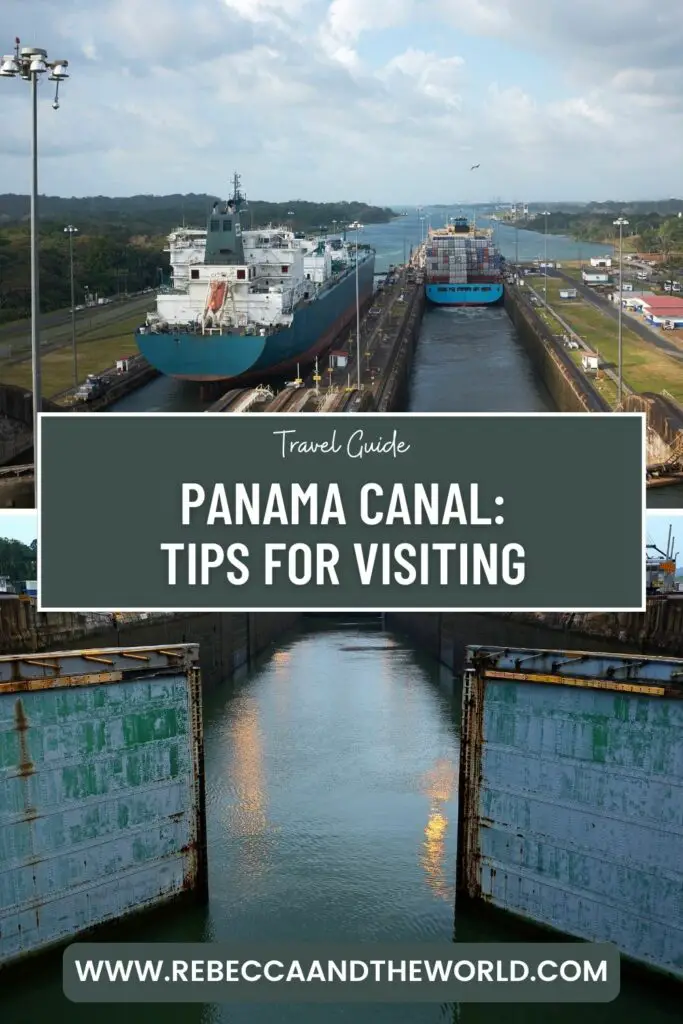
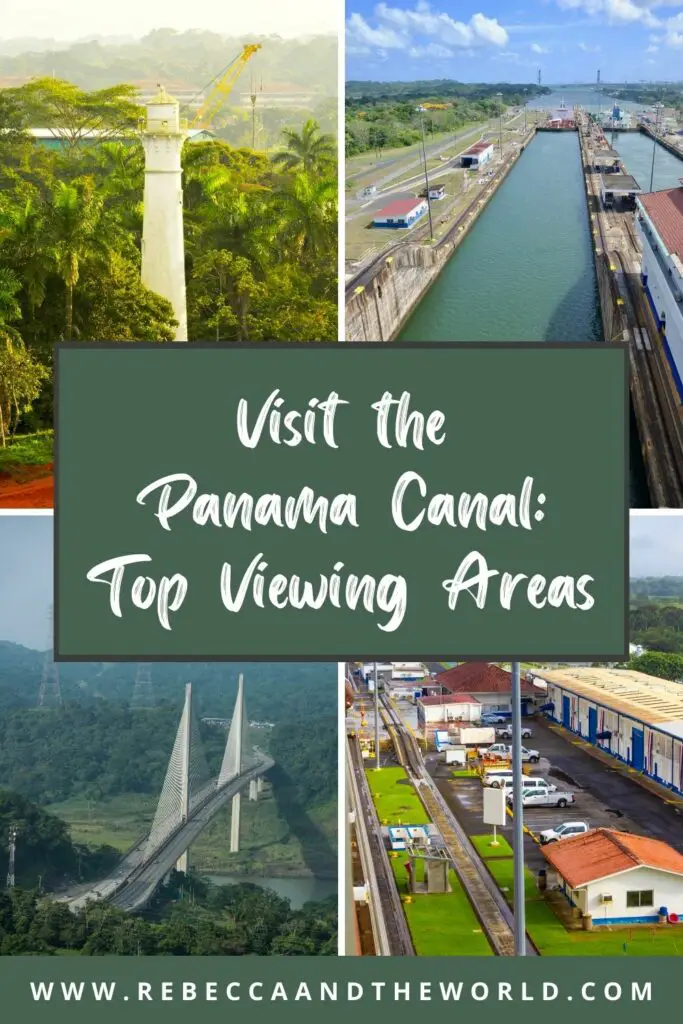



The Panama Canal experience is amazing. The only bad thing is the heat is a Satan here and the humidity is a Hitler! I love Panama besides these 2 minor details! LOL. Food and people and things to do is unprecedented!
We are taking 30 high school kids to Nicaragua on a service trip and will have a 4 hour layover in Panama. Wanted to take the kids to see the canal or the ruins. Do you have a recommendation over which can be done in the shortest amt. of time and would have the greatest impact?
You MUST visit the Miraflores Locks in Panama City – they’re amazing and the kids will love it. And there’s a great lesson there in engineering and history too 🙂
I have tried to contact all the tour operators/ transport contacts on this thread, but every response has been that 4 hour layover is not enough time to make it to the locks and back. Would you concur?
What a shame! Yes, possibly might be a bit tight, if you have to get through customs, then travel to the locks and then get back to the airport. Sorry about that – would have been a great trip!
Thanks for checking out my post!
Frankly speaking, I do like the boat in this article. Thanks for your hard work.
Thank you for reading! The boats are enormous and look like they’re not going to fit through – definitely a finger nail-biting moment!
nice place, but also scary
Oh no it’s not that scary! You do obviously have to be careful, but the locks are a little way out of town.
Thanks for sharing your experience! The pictures are wonderful (using a nice camera too). I haven’t been to that side of the world so again, thank you for sharing a glimpse of Central America and the Panama Canal. Congrats on Freshly Pressed! LB
Thank you! The camera was actually just a point and shoot, but they did turn out pretty well. Central America is one of my favourite places in the world to visit and hopefully I’ll get the chance to go back one day. Thanks for stopping by and commenting!
informative post. I liked it.
Thanks for the kind words – glad you enjoyed!
Love that last picture! Now I kind of feel that my life would not be complete if i don’t pass through the locks at least one in my life…
It is pretty spectacular – and even though I’ve seen it up close I still have no idea how people think up these things! Quite amazing!
Best way to see Panama Canal? Work on a cruise liner as a photographer… you get to be the only ones allowed off the ship as it passes through the locks, to take photos of the transit.
5am, climb down a little rope-ladder dangling off the side of the ship, onto a small speed-boat which takes you and 2 other photogs ashore. Race ahead of the ship to meet her at the first set of locks where you have pretty much free reign of the locks, you can go wherever the lock workers go. Shoot the transit.
Back to your driver who then takes you to various hills and lookout points along the canal to photograph the ship as she moves through the lake.
Drive to the other side of Panama, shoot the last locks and then back on another speedboat to climb up the small rope-ladder onto the ship again. (all while the ship is moving) Its awesome!!
And Colón can be dangerous, I was hit on quite aggressively by a Russian who insisted that I get on his ship instead of mine and drink vodka with him, as well as having a machine gun pointed at me on the street… all in a days work!
Thanks for posting, brought back some memories!
Ooohhhhh, jealous!! That sounds amazing!!
It really ticks me off when taxi drivers and tour guide take advantage of tourists. Yes, Colon is not the safest place to be wandering around, and even in the free zone area you need to keep track of your purse–a friend of mine got pickpocketed. But it’s not like you need a guy with a gun around. In my opinion, it might just provoke further problems should you encounter them. There’s also a really nice hotel in the Colon area called Hotel Melia. (It’s outside of the main city area, of course.)
Have you been as a tourist to Colon?
I second that!
Thanks for the kind words!
Thanks for commenting!
Really sounds a great adventure with all the gun showing 😛
But is the water in the canal fresh water? I thought it would be ocean water.
The photos are amazing.
It was a great day out – the canal is amazing. The water is fresh – it all comes from a huge fresh water lake (which runs between the three locks) and that’s the water that’s used to raise and lower the levels so the ships can go through. And then all that water gets flushed into the ocean. Incredible!
Glad to share! And thanks for commenting!
Is it truly fresh water that flows through the canal? I guess I just assumed that it was a salt water to salt water route, and neglected to remember the artificial lakes are fed by rainwater…hence, fresh.
Yep, fresh water. Between the locks is a HUGE man made lake which is filled with fresh water from all the rain that Panama gets. And that’s what used in the locks and eventually flushed out into the sea. Amazing!
Amazing. Was it one of those things you see that when you look at it you can’t help but think, “I can’t believe people in the past built this.”?
Crystal
Totally! Who in the early 1900s thought that this was a possibility?? I’m constantly amazed by the things people think of!
Awesome post and awesome pictures! Sounds like you got in a hairy situation…. Well, I still want to go to Panama, even if it’s dangerous! 🙂
Awesome pictures? I do not like them very much.
Okay, well not everyone’s going to like my pictures!
Was it difficult to take them?
Thanks! I didn’t feel scared at all while I was there, or felt that I was in any danger. I’m sure there are issues in that particular town, but I’ll hazard a guess that the touts play it up a bit to get customers!
You should definitely go!
Amazing post and photos!
Thanks so much!
very nice pics… one day I will get down there to see them in person!
You should! Panama is an amazing place.
The locks in the current Panama Canal are exactly 110 feet wide by 1,050 feet long. The canal was built around 1910, when ships were a lot smaller. I was stationed with the U.S. Navy there many years ago and can recall that when the battleship U.S.S. Iowa transited the canal, the crew had to go over the side after leaving the canal to repaint the ship where the paint was scrapped off by the sides of the canal locks.
The Panamanians have a new project to build new canal locks to accommodate larger ships.
It must have been amazing to be stationed there!
By the way, I just looked at your blog – amazing poetry!
Wow, your last picture is just incredible! That ship is almost about to hit the banks! Why the heck didn’t they make that canal wider? Or the ships smaller? 🙂
It’s crazy, isn’t it? I spent the whole time biting my nails, waiting for it to crash into the sides! I think they’re about to start (or may have started) a massive program to widen the canal so that even bigger ships can get through!
They have! That’s why we are living here at the moment – my husband is working on the expansion project.
I know right?
It look soooooooooo narrow!
lol
Great pics by the way Rebdcca
Great Post!!! The pictures are amazing! This is still on my travel list to see……… 🙂
Thanks! Definitely get there if you can – absolutely stunning to see in person.
This is really informative I suppose I should put my plans to the panama on hold until I can bring along a few guys!
Oh no, don’t be too worried! I found Panama to be very safe and had no problems at all. I’m certainly not going to question the safety of Colon – after all, if everyone’s saying it then there must be something to be concerned about! – but there are plenty of ways to see that side of the country safely.
Fantástico, a primeira foto dá até vertigem.
Alguém sabe dizer se (imediatamente) o nível de água de cada oceano é o mesmo?
Nice story, you know, us in Canada we actually use the same “floodgate” concept along the Saint-Laurence river, to get ships form the sea, to the Greak Lakes.
The Saint-Laurence river? The Great Lakes are quite known.
Thanks! It’s quite amazing how these things work. I’m not familiar with the Great Lakes but I’m interested to find out more!
great post, great photos!
Thank you – appreciate your kind words and taking the time to read it.
So informative! The photographs were great too. 🙂
http://www.denwrites.com
Thanks! I’m no photographer though, so need to work on that… Have a great day!
I loved this post! Great shots! very informative. Made me feel like I was there! Great job.
Thank you! Particularly coming from someone who can photograph (unlike me!) – your site is amazing!
Great article, fabulous pics! We have been to Colón twice now, and not yet set foot outside the car! I don’t know if it is as dangerous as the guide books make out but we weren’t taking any chances with our three young children. We tried to find Gatun from Colón but failed! Maybe next time…
Hey! Thanks for the comment. You should definitely try to get to the locks if you do go back to Colon – they’re quite safe and outside of Colon town. And I particularly found them so much better after seeing Miraflores. But I can certainly imagine that you always need to be cautious with kids and shouldn’t take any unecessary risks.